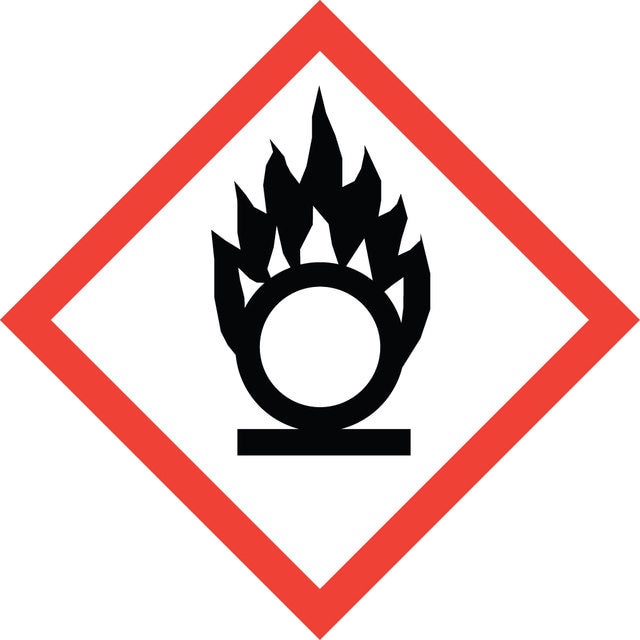形式
solid
组成
Pt, 81-83%
reaction suitability
core: platinum
reagent type: catalyst
环保替代产品特性
Designing Safer Chemicals
Catalysis
Learn more about the Principles of Green Chemistry.
表面积
≥60 m2/g
mp
450 °C (lit.)
环保替代产品分类
SMILES string
O=[Pt]=O
InChI
1S/2O.Pt
InChI key
YKIOKAURTKXMSB-UHFFFAOYSA-N
正在寻找类似产品? Visit 产品对比指南
警示用语:
Danger
危险声明
危险分类
Ox. Sol. 1
储存分类代码
5.1A - Strongly oxidizing hazardous materials
WGK
WGK 2
闪点(°F)
Not applicable
闪点(°C)
Not applicable
个人防护装备
Eyeshields, Gloves, type P3 (EN 143) respirator cartridges
分析证书(COA)
输入产品批号来搜索 分析证书(COA) 。批号可以在产品标签上"批“ (Lot或Batch)字后找到。
已有该产品?
为方便起见,与您过往购买产品相关的文件已保存在文档库中。
难以找到您所需的产品或批次号码?
如何查找产品货号
在网站页面上,产品编号会附带包装尺寸/数量一起显示(例如:T1503-25G)。请确保 在“产品编号”字段中仅输入产品编号 (示例: T1503).
示例
其它示例:
705578-5MG-PW
PL860-CGA/SHF-1EA
MMYOMAG-74K-13
1000309185
输入内容 1.000309185)
遇到问题?欢迎随时联系我们技术服务 寻求帮助
如何查找COA批号
批号可以在产品标签上"批“ (Lot或Batch)字后面找到。
Aldrich 产品
如果您查询到的批号为 TO09019TO 等,请输入去除前两位字母的批号:09019TO。
如果您查询到的批号含有填充代码(例如05427ES-021),请输入去除填充代码-021的批号:05427ES。
如果您查询到的批号含有填充代码(例如 STBB0728K9),请输入去除填充代码K9的批号:STBB0728。
未找到您寻找的产品?
部分情况下,可能未在线提供COA。如果搜索不到COA,可在线索取。
Which document(s) contains shelf-life or expiration date information for a given product?
If available for a given product, the recommended re-test date or the expiration date can be found on the Certificate of Analysis.
How do I get lot-specific information or a Certificate of Analysis?
The lot specific COA document can be found by entering the lot number above under the "Documents" section.
In which solvents is Product 206032, Platinum (IV) oxide, soluble?
Per the the chemicals encyclopedia published by the Royal Society of Chemistry, 13th Edition, when freshly precipitated, Platinum(IV) Oxide is soluble in concentrated acids and dilute phosphoric acid, especially when warmed. It is easily soluble in dilute solutions of potassium hydroxide.
Is Product 206032, Platinum (IV) oxide, water soluble?
It is insoluble in water.
How can Product 206032, Platinum (IV) oxide, be used as a catalyst?
Platinum(IV) oxide can be used as a catalyst in hydrogenations. The actual catalyst is platinum black which is formed in situ by reduction of the PtO2 by the hydrogen used for the hydrogenation. It is especially useful for reduction at room temperature and hydrogen pressures up to 4 atmospheres. It is suitable for the reduction of double and triple bonds, aromatic nuclei, carbonyl groups, nitro groups, and nitriles.
Are there any safety concerns with Product 206032, Platinum (IV) oxide?
After exposure to hydrogen, the resulting platinum black can be pyrophoric. Therefore, it should not be allowed to dry and all exposure to oxygen should be minimized.
Can the Platinum be recovered from Product 206032, Platinum (IV) oxide?
Internet sources do indicate that Platinum can be recovered from spent catalyst by conversion to ammonium chloroplatinate using aqua regia followed by ammonia. However, we do have a process for doing so.
How do I find price and availability?
There are several ways to find pricing and availability for our products. Once you log onto our website, you will find the price and availability displayed on the product detail page. You can contact any of our Customer Sales and Service offices to receive a quote. USA customers: 1-800-325-3010 or view local office numbers.
What is the Department of Transportation shipping information for this product?
Transportation information can be found in Section 14 of the product's (M)SDS.To access the shipping information for this material, use the link on the product detail page for the product.
My question is not addressed here, how can I contact Technical Service for assistance?
Ask a Scientist here.
商品
Oxidation and reduction reactions are some of the most common transformations encountered in organic synthesis
Oxidation and reduction reactions are some of the most common transformations encountered in organic synthesis, and are some of the organic chemist’s most powerful tools for creating novel products. Below is a list of the most commonly used oxidizing and reducing agents currently available in our catalog.
我们的科学家团队拥有各种研究领域经验,包括生命科学、材料科学、化学合成、色谱、分析及许多其他领域.
联系技术服务部门